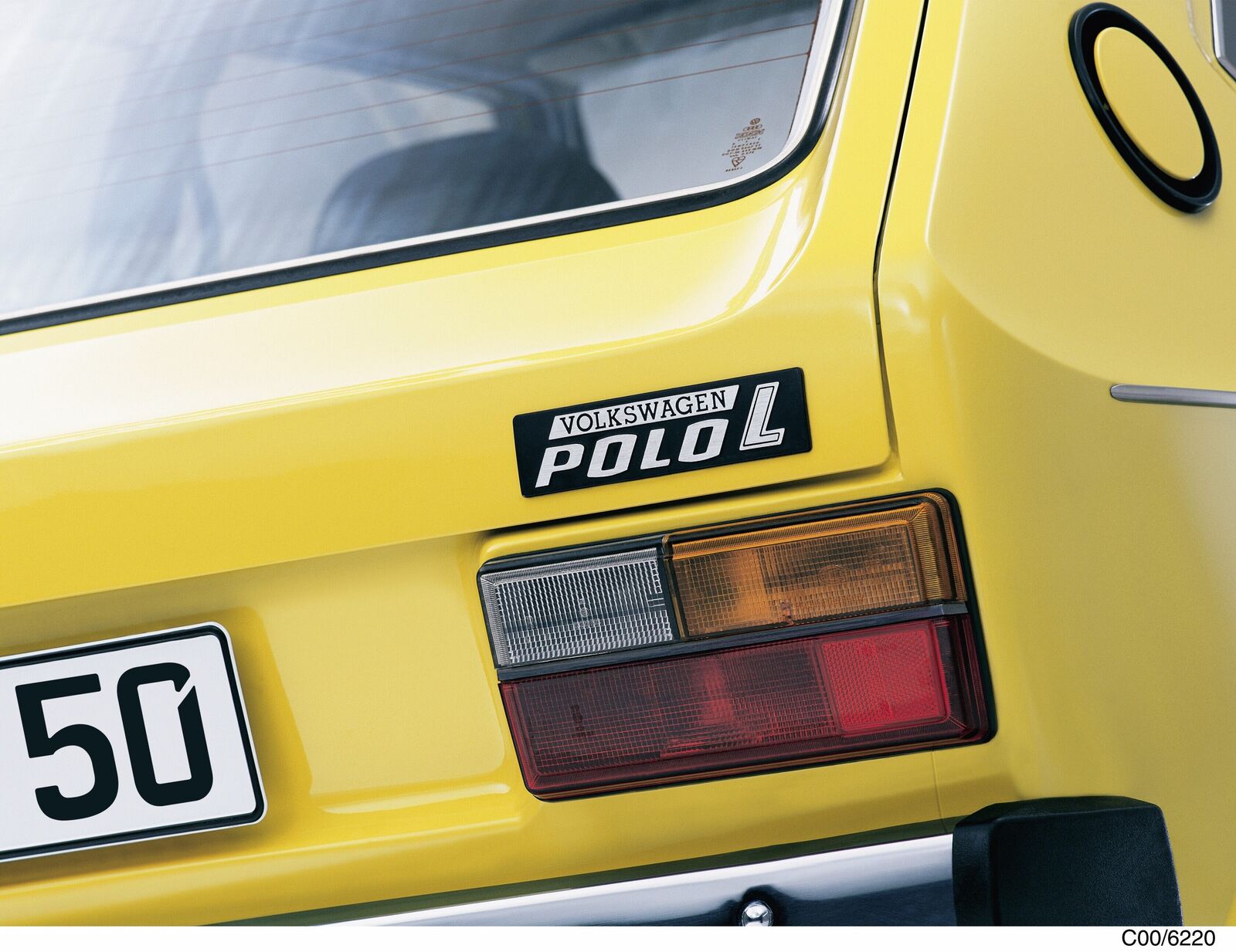- Happy Birthday, Polo! – Volkswagen started the market launch of the Polo at the beginning of May 1975, and it continues to shape the compact car segment to this day
- Efficient, affordable, innovative and practical: the Volkswagen Polo stands for affordable entry-level mobility and the democratisation of technical progress
- More than 20 million units have been sold worldwide to date
“Small on the outside. Big on the inside.” This was the slogan used by Volkswagen 50 years ago to advertise its latest product at the time, the Polo. When the small car came on the market in early May 1975, nobody expected that the extremely compact two-door vehicle would become a bestseller – nationally and internationally, over five decades, in six generations, with several prestigious awards, with more than 20 million units sold and as a pioneer in the compact car segment.
Polo stands for affordable entry-level mobility. When the first new Polos were on sale at dealerships, they were part of a new Volkswagen model family that took over the streets in the early 1970s. In the spring of 1975, the angular small car followed the Passat (1973) and Golf (1974) of the then still young water-cooled model generation, which succeeded the legendary VW Beetle. Throughout six model generations, it is clear that the overall concept – consisting of a fair price-performance ratio, high utility value, pioneering technology for the small car class and, of course, its attractive design – is still popular today and has made the model a bestseller. In addition, the Polo has succeeded in shaping the compact car segment for decades. Recognition from national and international trade media includes awards such as Car of the Year 2010, World Car of the Year 2010 and World Urban Car 2018.
Trendsetter and serial winner. What began as a simple two-door vehicle in 1975 has been perfected and expanded in many facets over five decades: in a total of six generations, as a hatchback Polo, as a coupé, as a sporty G40 or GTI, as a colourful Harlequin, as an estate, as a notchback with the name Derby, as a CrossPolo with a striking off-road look, as an efficient Polo BlueMotion and, of course, as an extremely dynamic Polo R WRC, which was crowned with four World Championship titles in the World Rally Championship from 2013 to 2016.
Democratising innovation. Each generation of the Polo has offered more space and comfort, more efficient engines and innovative safety features. New features such as front and side airbags, power steering, belt tensioners and ABS were introduced and made sure the Polo remained successful. The next major step followed with the modular transverse matrix (MQB) platform, which set new standards in terms of connectivity, safety and driving dynamics and made the model even more digital and innovative. Today also, the small car boasts assist and convenience systems that are otherwise available only in higher vehicle classes. The model continues to be very popular worldwide and will be kept up to date in 2025. A perfect example of this is the Polo GTI, which can now be driven even more dynamically – thanks to Electronic Stability Control (ESC) that can be be deactivated, performance tyres and a new suspension and steering set-up.
Global production and worldwide success. Series production of the Polo I began in March 1975 at Volkswagen’s headquarters in Wolfsburg, with 1.1 million units being produced there by 1981. As the model increased in importance, production was spread to other locations around the world, including Spain, Argentina, South Africa, Slovenia, China, Brazil and India. With more than 20 million units built, the Polo is one of the world’s most successful small compact vehicles.
Overview of the Polo generations:
Polo I – The first Polo, presented in Geneva in March 1975, was a simply equipped two-door model compared with the Audi 50, on which the new Volkswagen was technically based, and which was offered in parallel by Audi. The Polo, initially available with a 29 kW (40 PS) engine, impressed with an outstanding price-performance ratio and high utility value. With a length of 3.50 metres, it offered space for four people plus luggage. The original version of the Polo was produced until 1978, the updated version until 1981. More than 1.1 million vehicles were produced, including the Derby notchback version with spacious load compartment, built from 1977 to 1981.
Polo II – In September 1981, Volkswagen presented the second generation of the Polo with a completely redesigned body that grew to 3.66 metres. This squareback Polo model was a two-door small estate with generous space. Only one year later, a fastback coupé with more powerful petrol engines followed. The Polo Coupé GT40 was launched as a limited-edition model in 1987, the most powerful variant to date with 85 kW (115 PS). As an economical variant, the smallest diesel engine with an output of 33 kW (45 PS) also made its debut in the Polo in 1987. The Polo II was produced for a total of 13 years, with more than 2.7 million units sold.
Polo III - The third completely revamped generation followed in 1994: with a new body, chassis and engines. This was also available as a five-door model for the first time. The increased exterior dimensions ensured improved space, and modern safety systems such as airbags, belt tensioners and ABS were introduced. In 1995, one of the most curious Polo models was launched: the Polo Harlequin, whose four colours could be combined in a modular design. From 1997, the Polo was available as an estate. A limited special series made its debut in 1998: the Polo GTI with 92 kW (125 PS), which now also featured the three magical letters for the first time. A total of 3.5 million Polo III models were produced.
Polo IV – The fourth-generation Polo, introduced in 2001, had a new design with four large clear-glass headlights and was 15 centimetres longer and 5 centimetres wider than its predecessor. It now offered a luggage compartment volume of 1,030 litres with the rear seats folded down. New engines, including three-cylinder engines and powerful turbocharged engines in the Polo GTI, provided more power. Safety features such as front and side airbags, power steering and ABS were on board as standard. The Polo GTI (now with 110 kW/150 PS) followed in 2006, along with the CrossPolo in a robust off-road look and the Polo BlueMotion (with CO2 emissions of only 99 g/km). A total of 4.1 million fourth-generation models left the factory gates.
Polo V – The fifth-generation Polo, which celebrated its world premiere in March 2009, was longer than its predecessor with a length of almost four metres. The design was characterised by clean lines. Five new engines complemented the model range, including the Polo BlueMotion, which was introduced in December 2009 and consumed only 3.3 litres of diesel on average for 100 kilometres. The sporty Polo GTI was part of the model range again, and the Polo R WRC Street special model with its 162 kW (220 PS) TSI engine was available to order for the first time. The fastest production Polo to date brought the motorsport feeling of the World Rally Championship (WRC) to the road. Volkswagen sold a total of 6.3 million Polo V cars between 2009 and 2017.
Polo VI – The sixth-generation Polo, introduced in 2017, was based for the first time on the modular transverse matrix (MQB) platform, giving it numerous optional features from higher vehicle classes. These included Automatic Emergency Braking (Front Assist) with City Emergency Braking System and Pedestrian Monitoring, lane change system with blind spot monitor and Adaptive Cruise Control (ACC). Thanks to the modular concept, the Polo grew in length by 81 millimetres and now offered a luggage compartment volume of 351 litres. In 2021, the Polo was comprehensively revamped with a sharpened body design and new optional features such as IQ.LIGHT matrix LED headlights and assist systems such as IQ.DRIVE Travel Assist. The cockpit was digitalised and offered displays with screen diagonals of up to 25 centimetres as well as numerous digital features such as wireless charging and App-Connect. The new Polo GTI followed in summer 2021 with a powerful two-litre turbocharged petrol engine and an output of 152 kW (207 PS). In 2023, the limited-edition special model Polo GTI Edition 25 made its debut with exclusive equipment to mark the 25th anniversary of the Polo GTI. Volkswagen has produced more than 2.5 million units of the Polo VI to date.
Further information and image material for all generations can be found on our special page for the Polo anniversary in the Volkswagen Newsroom (volkswagen-newsroom.com).
Media




Media contacts
Tel. +49 (0) 151 29263119

